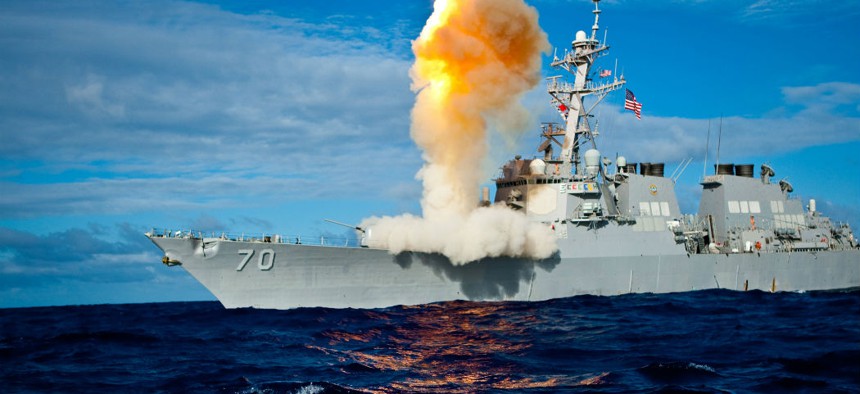Navy searches for next-gen X-band radar for surface warships.
The Navy is entering tech development for a new lightweight, phased array radar.
The Navy is beginning the process of improving its current AN/SPQ-9B X-band radar and creating a next-generation low-cost, lightweight, active phased array radar by 2027. In September, the Office of Naval Research held an Industry Day for its Future X-band Radar, or FXR, program. The program is entering the technology development and risk reduction stage.
The new radar will have multiple capabilities, including anti-aircraft search and tracking, surface target search and track, detecting submarine periscopes, and identifying unidentified targets. The radar will be retrofitted to older vessels as well as equipping new ships. And, it should cost less than $30 million per system.
The Navy makes clear that it considers X-band the only suitable wavelength for its next-generation surface radar. "With limited availability of other maritime radiolocation radio frequency spectrum, other bands will not be considered," the Navy said.
X-band radar does have the advantage of a smaller wavelength, and smaller antenna, than the S-band radars used by many surface ships. "Antenna size requirements decrease as frequency increases for a given beam width," said Trevor Snow, a radar and electronic warfare product manager for ONR. "Conversely, microwave amplifiers offer less power at higher frequencies and signal losses are worse, so operating at X-band is a trade between those considerations."
"This system would offer improved capabilities over the AN/SPQ-9B system and the trade studies will highlight what advantages are achievable within size, weight, power, and cost constraints," Snow added.
Size, weight, power and cost, or SWAP-C, are among several considerations listed in a recent Navy presolicitation. The Navy wants to develop baseline concepts for FXR, come up with realistic SWAP-C and effective isotropic radiated power, or EIRP, estimates based on flyaway cost, and assess the state of current technology and what new technology is required to make FXR work.
"FXR will support surface warfare gun engagement and anti-ship cruise missile defense," according to the presolicitation. "In order to extend the radar horizon, the Navy is interested in concepts suitable for installation at heights high above the waterline, near or at the top of ship masts, on current and future surface combatants as well as other platforms currently designated for AN/SPQ-9B." Because of cost considerations for new antenna arrays, there may also be a need to develop high efficiency X-band transmit/receive modules and power amplifiers.
The Navy underscored a list of special requirements for the new radar, including:
- operating for a 120-day mission without critical failure.
- optimizing bandwidth to avoid low-elevation multipath effects which make it harder to detect low-flying objects such as sea-skimming missiles. At the same time, the new radar must be interoperable with other sensors and transmitters.
- not generating too much heat. "Since cooling capacity of ships is a constraint, the use of improved technologies to reduce the heat load on ship service cooling is a particular focus area," the Navy said. "Designs featuring higher efficiency technologies in power amplification, receiver components, advanced cooling, efficient signal processing, and other engineering innovations to control heat load are desired."
The U.S. military is turning to X-band radar for more than surface ships. For example, the Missile Defense Agency awarded a $1.5 billion contract to Raytheon last month for the Army Navy Transportable Radar Surveillance Model 2 X-band radar and the Sea-Based X-band radar system.




